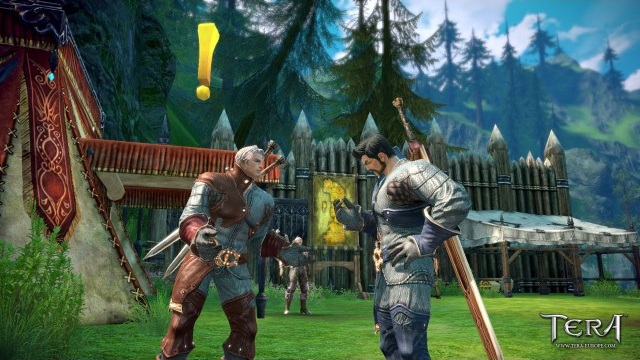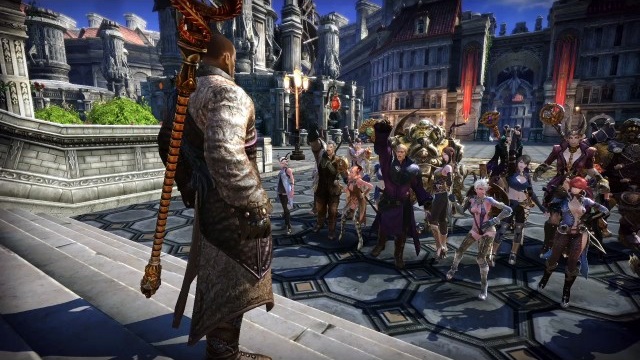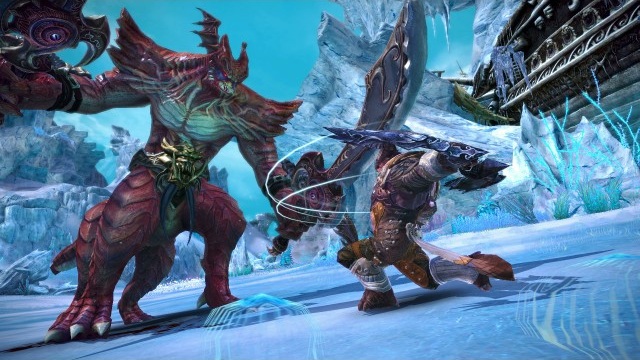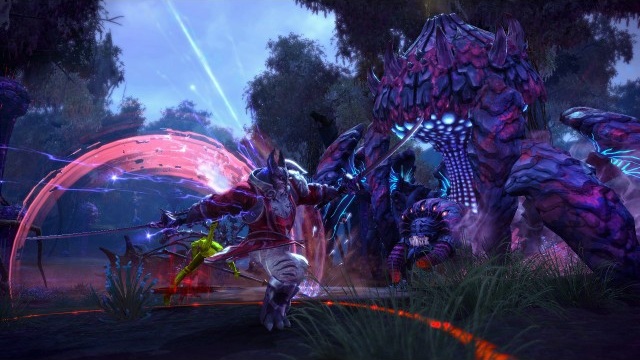Tired of standing around spamming buttons? TERA’s what the doctor ordered.
10 years ago when I was just a naïve, little snot in high school, people asked me if I was going to play Final Fantasy XI. It was a different time then: You couldn’t walk around for more than an hour without hearing Eminem, the Spider-man film series had just begun its wonderful maiden voyage long before emo-Peter Parker and Sandman fucked it up, and if you asked someone what an MMORPG was, the most likely answer you’d get (other than a blank stare) would be something along the lines of “Oh, that’s kind of like an Everquest, right?”
And in that antiquated bygone age, I would reply to the FFXI query: “Nay, good sir! For I refuse to support the practice of charging anything beyond the original purchase price of my digital entertainment!” If only my younger self could have glimpsed the future, with our DLCs and Xbox LIVEs and micro-transactions, he very well may have forsaken this hobby altogether.
But then a few friends suckered me into WoW, and I’ve been playing—and paying—for eight years now. And because of that one tiny, little fact, that indignant, righteous kid who once vowed never to touch an MMO would eventually be deemed “the MMO guy” at Game Revolution.
That title is both a blessing and a curse. When MMOs are done right, they are magically addictive. When done wrong, they can be downright excruciating. Thankfully, Tera lies much more in the former camp, but it also takes some bewildering steps backward. It seems that every new MMO that does something fun and innovative inevitably messes something else up in the process.
Rift did some amazing things with massive world events and bosses that hundreds of players could work on together, but the class and talent system were a hopeless mess. The Old Republic created the best leveling experience in an MMO hands down, without the end-game or coherent PvP to back it up. You can probably guess from these examples I’m throwing out that Tera is going to be another “win some, lose some” type of experience.
But where it wins, it wins big. If you’ve had any interest in this game previously then you know that the action combat system is its defining feature. For the most part, it doesn’t disappoint. It feels far more visceral, exciting, and engaging than traditional MMO combat and more refined than previous action MMOs such as Vindictus.

Unlike your traditional MMO control scheme, Tera uses the mouse to control the camera by default while the WASD keys control basic movement, just like an FPS. There is a controller option, but unless you have a monster of a controller with an arsenal of buttons, stick to the keyboard and mouse and never look back. It feels odd at first if you’re used to other MMOs, but you’ll quickly get used to it and understand that this control scheme is the only way Tera can successfully pull off the style of combat that it does. The quick, precise camera control is necessary to keep your target within the targeting reticule to properly aim attacks and spells.
And aim you will. Even the biggest and heaviest of BAMs (that’s the game’s official acronym for Big Ass Monster, which in turn is the official term for most bosses and mobs that need a party to take down) can move with explosive quickness, and most abilities do not simply seek their target automatically as in the typical MMO—at the very least requiring a mouseover with the reticule to “paint” the target before locking on.
As for self-preservation, almost every class has a built-in evasion skill, ranging from simple backsteps to acrobatic flips, rolls, and full-blown teleportation. To avoid damage, it’s key to use these abilities right before big attacks land, which requires a keen eye as well as the experience to spot a monster’s choreographed animation. Most of the time the big attacks are preceded by a brief red flash in the monster’s eyes, but plenty of them are sneakier than that and need to be observed carefully to predict their movements.
The end result is that the combat handles similar to that of single-player games, with melee classes taking several cues from hack-and-slash games and ranged classes bringing more of a third-person shooter feel. The one exception is the Lancer, one of two tank classes in the game that is made to stand fast and absorb damage through blocking. Instead of evasive maneuvers, the Lancer simply has a block ability which will plant your feet and reduce damage to you and anyone behind you as long as you hold the button down.

In contrast, the other tank class—the Warrior—cannot take the same beating and plays as an evasion tank. I found the Warrior to be the most fun class by far, constantly dodging, backstepping, flipping over the heads of my enemies as they try to land a strong attack, and getting a few strikes in with my twin swords while they were open. It takes a lot more attention and reflexes to play properly, but that back-and-forth flow of dodging around and quickly attacking when the time is right is thrilling and not unlike a battle in, say, God of War.
The other two melee classes—Berserker and Slayer—both wield two-handed weapons, focus on DPS, and play fairly similarly. The Berserker is slower and uses charged strikes to deal devastating—albeit unreliable—damage, while the Slayer has average speed and more sustained damage that focuses on knockdowns.
Getting into the ranged classes opens up a whole other can of worms. The DPS mainstays, Archer and Sorcerer, can sit back and blast away more often, not needing to be as mobile as their melee counterparts. That doesn’t mean, however, that they don’t need to pay as much attention. Proper aim and prediction of a monster’s movement patterns are essential to minimizing those missed shots and thus maximizing “the deeps”.
Even healers need to be on their toes, because standing still and chain casting won’t cut it in Tera. Most of the spells from the main healer, the Priest, are either limited AoE spells or targeted heals that require a lock-on with mouseovers as well, only they lock onto allies instead of enemies. And the Mystic, which functions as a secondary healer and all-around support class, can create health and mana pickups on the ground that anyone can use. Thus even the healing classes, while not requiring as much movement and precision as their peers, still have to do their fair share of running around and playing smart to keep the party alive.

End-game content introduces an intriguing feature with a lot of potential: the Political System. Every three weeks, a veteran guild leader of at least level 50 can run for Vanarch in any of the zones in the game. They can campaign in-game, make campaign videos that they can post to server forums, and even pay people for votes (pretty much like real politicians). Any character at least level 20 can vote. An elected Vanarch gets access to some nifty things, like special super-fast mounts for themselves and their guild. They can also activate special vendors within their zone, open up teleport routes, and set taxes on vendors which they can keep for themselves (again like real politicians).
Rounding out the list of cool things about Tera is the graphics, which maintain a constant level of quality throughout. While still not as impressive overall as that terrifying MMO which shall not be named, Tera pulls off some jaw-dropping moments, such as when particularly nasty BAMs burst through walls and start wailing on the group. The moment that you first fly into the major city of Velika is absolutely stunning, opening up with an incredible view of the vast cityscape made all the more extraordinary when you actually land and understand that every inch of it can be traversed on foot.
PvP is an interesting endeavor. It requires more skill than in other MMOs due to the game’s nature of combat. In that regard, I found the quicker melee class to have the edge in PvP. Someone good at dodging can nimbly evade the hits of slower classes, although if just a few of those hits manage to land, they’ll be in a world of pain. Guild vs. Guild battles are also a feature, and allow for grand battles with dozens of guild members. These battles seem to degenerate into wars of attrition and numbers to a casual observer like myself who’s admittedly not the best PvPer, though I’m sure a master strategist would tell you differently.
And now we’ve arrived, inevitably, at those missteps that I mentioned earlier. Unlike the previous examples of Rift and SWTOR, there aren’t really any one or two things about Tera that jump out as exceptionally problematic. It’s a series of little things, rather, that add up to a constant nagging frustration that’s always lingering as you try to enjoy the more awesome parts of the game.
Each of these things are little backward steps for the MMO genre, like the game's nature of questing. SWTOR proved that questing didn’t have to always be “kill X of this or collect Y of that”, but the vast majority of quests in Tera follow that same tired formula. The pacing and progression of quests leading from area to area is excellent, but the quests themselves are boring and almost asking to be clicked through without reading.
On top of that, there are bewildering interface issues that other MMOs solved long ago. When a monster dies in Tera, the loot doesn’t sit on its corpse but the gold and each item fall to the ground in a shiny bauble. It’s kind of cool and more immersive to pick the loot up off the ground, but for some reason there is no AoE looting option, something that’s become standard in the genre. Even WoW is finally jumping on the AoE loot wagon in Mists of Pandaria.

And when you’re mounted up, you can’t do anything except talk to NPCs. That would be all well and good, except that when you need to take an action, the game doesn’t auto-dismount you, like… pretty much every other MMO I’ve played. Need to craft gear? Use an item? How about something simple like smacking a monster in the face? Nope, no auto-dismount for you. You’ll have to hit the button again first to toggle your mount off. Every. Single. Time.
Last, the nature of the controls can sometimes interfere with the intuitiveness of gameplay. Since the mouse controls the camera by default, you have to go into UI mode to switch it to traditional cursor control to do things like check your spellbook and rifle through your bags. Outside of combat that’s not a problem, but anyone who’s played an MMO before knows that you’ll inevitably find yourself in situations where you need to use an item during combat or find that spell that you forgot to put on your bar. When these situations occur in Tera, going into UI mode means that you sacrifice your ability to move and function effectively in combat. It’s kind of an unavoidable consequence of Tera’s control scheme, but it’s an occasional problem nonetheless.
I didn’t expect that much from Tera going into it, but I came out pleasantly surprised. What the game does well it does very well, the action combat system being the foremost example of that. There’s no shortage of small missteps that interfered with my total satisfaction with the game, made even more annoying by the fact that most of them could have had simple fixes. But the good does significantly outweigh the bad, and if you’re looking for an MMO that plays very dynamically and differently from most of the pack, Tera is right up your alley.
-
Great combat system
-
Varied and entertaining selection of classes
-
…especially the Warrior!
-
Political system adds some flavor to end-game
-
Consistent level of graphical quality with some truly great moments
-
Takes several frustrating steps backward in MMO quality-of-life
-
Controls make it difficult to use any UI interface during combat









